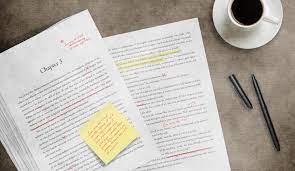Creating a novel is really challenging. Once you reach the end of your first draft, there’s a brief sigh of relief, but it doesn’t last. The overwhelming task of self-editing makes writers feel like a massive wall looming just ahead.
No matter if you are a top-notch novelist, a skilled ghostwriter, or a self-publishing beginner working on your first novel, you’ll need a significant investment of your time to edit a novel.
Editing might seem daunting for many writers, but with the right strategies, it can actually be an enjoyable process. By following the correct approach, you can edit your novel effectively and even find joy in the process.
If you’re not sure where to begin with editing your short story, take a look at the step-by-step guide below. It will help you navigate the editing process, whether you’re working on the first draft or putting the finishing touches on the final version!
How To Self-Edit Your Novel Or Short Story? – Follow This Guide
According to the professional ghostwriters, here are the key steps to help you self-edit your novel:
Get Your Story Printed Out
One of the first steps in the self-editing process is to distance yourself from the digital screen and hold a tangible copy of your manuscript. When you have printed out your story, it will be easier for you to have a fresh perspective on the story.
As it allows you to notice details that might be overlooked on a computer or tablet screen. Physically flipping through pages can offer a unique experience, often leading to fresh insights into the flow and structure of your narrative.
Read Your Story Loud
The power of reading your story aloud cannot be overstated. When words are spoken, their pace and rhythm become more visible.
This step helps in identifying mismatched phrasing, run-on sentences, or parts where the story may lose momentum. Listening to your words engages a different sensory input, making it easier to catch grammatical errors and typos that might have slipped through during silent reading.
Read The Story Again While Taking Notes This Time
After the initial read-through, you need to get a more focused inspection of your manuscript. In this section, you will take notes on specific elements that stand out, whether positive or negative.
All you need to do is note down the inconsistencies in character behavior, plot holes, or any moment where the story feels disjointed. These notes will serve as a roadmap for the editing process, guiding you through targeted improvements.
Write Notes On How Each Paragraph Moves The Story Forward
Every paragraph in your story should contribute to its overall progression. And to achieve this, you need to review each paragraph critically, asking yourself how it advances the plot, develops characters, or enhances the thematic elements.
If a paragraph lacks purpose, think about revising or removing it. This careful approach guarantees that every aspect of your narrative plays a meaningful role in the whole story.
Evaluate Your Character And Theme
Characters serve as the heart of any story, while themes add depth and meaning to the narrative. So, before you move to the next, take a step back and assess the consistency of your characters. Make sure the character’s actions align with their established traits and motivations.
At the same time, examine the theme to ensure it remains a guiding force throughout the story. Characters and themes should evolve cohesively, enhancing the overall quality of the narrative.
Ask Your Friend To Read The Story And Give Feedback
External perspectives are invaluable during the editing process. Talk to your friend, preferably someone with a keen eye for storytelling, to read your manuscript.
Their fresh viewpoint can uncover elements you might have overlooked. Though, it’s necessary to accept all honest feedback, focusing not only on what works but also on areas that need improvement. Doing this will significantly help you to make your work better.
Make A List Of Necessary Changes For Your Next Draft
Create a thorough list that has all the changes and improvements identified during the self-editing process. Organize these revisions based on priorities, whether they involve character development, plot refinement, or thematic enhancements.
This organized approach simplifies the editing process for your next draft, ensuring you address each aspect systematically.
Rewrite And Edit Your New Draft
Once you have gained insights from your self-editing journey and feedback from others, get on the task of rewriting and editing your new draft. Here, you will need to implement the changes outlined in your notes, purifying sentences, sharpening dialogue, and enhancing the overall narrative.
Thus, this stage is all about fine-tuning and polishing, ensuring your story shines with clarity and impact.
Conclusion
In summary, self-editing is a refining journey of your novel. Every step, from printing your story to gathering external feedback, plays a role in the success of your manuscript.
So edit your document carefully, as understanding each revision brings your story one step closer to reaching its full potential.


